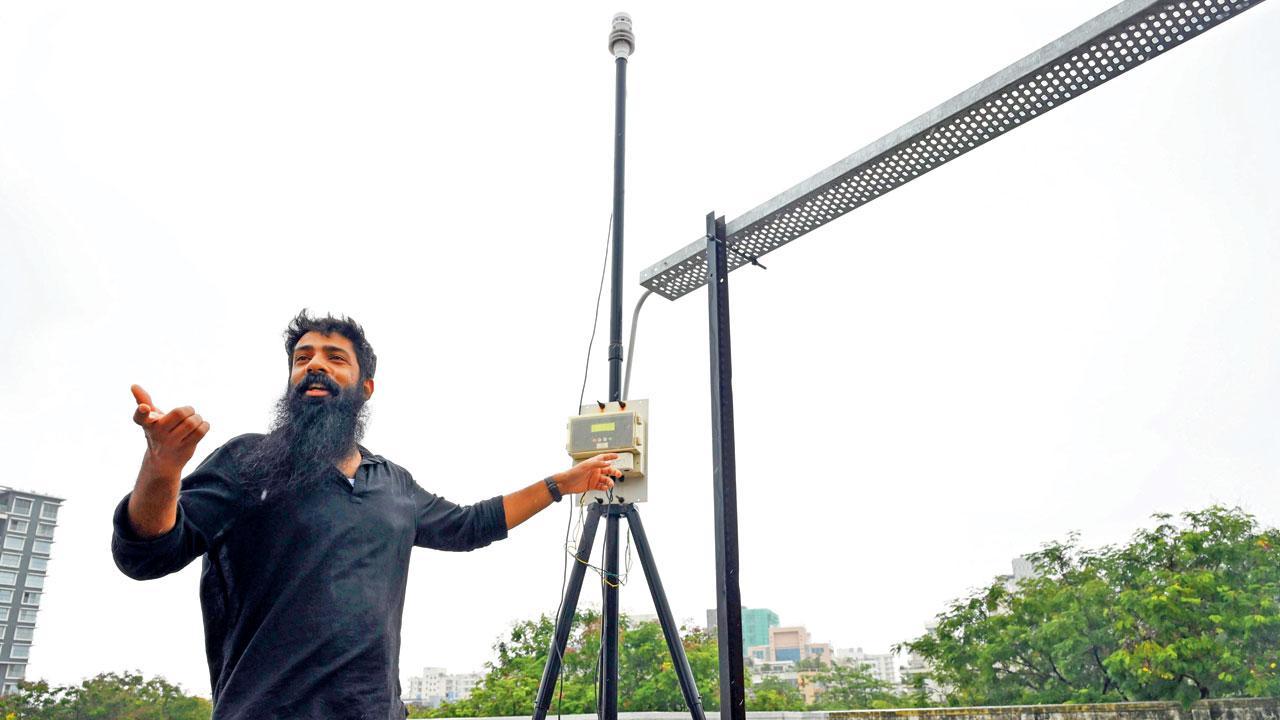Two architects turn coders to enable a unique project that could predict and project the changing micro-climate of Mumbai, and its after effects

A view of the climate microsensor at the KRVIA terrace
Walk into the Kamla Raheja Vidyanidhi Institute of Architecture (KRVIA), and the cool vibe is a stark contrast to the corporate ambience of its corridors. The college is a hub of buzzing students milling about new ideas, designs and creations. This is not limited to the students though. Down the corridor from the classrooms, Assistant Professor Ankush Chandran is busy at work on a seemingly normal computer. The data he is reading though tells another story.
Walk into the Kamla Raheja Vidyanidhi Institute of Architecture (KRVIA), and the cool vibe is a stark contrast to the corporate ambience of its corridors. The college is a hub of buzzing students milling about new ideas, designs and creations. This is not limited to the students though. Down the corridor from the classrooms, Assistant Professor Ankush Chandran is busy at work on a seemingly normal computer. The data he is reading though tells another story.

The geomapped space in Aarey forest
For the last two years, 31-year-old Chandran and fellow professor and collaborator, 55-year-old Aneeruddha Paul, have been working on a system that seeks to monitor urban microclimate. “We started the self-funded project in 2022, and have now set up the equipment and sensors. Over the last year or so, we have been gathering steady data for computation and analyses,” Chandran reveals.
Tool building
The project took off from another idea for a possible collaboration with organisations working in urban design realm in 2021 that Chandran was part of — the geo-mapping of Aarey Forest. While the project is still in the planning stage, the methodology of using artificial intelligence (AI) to analyse the data set the team on a different path.

Ankush Chandran working the data at the computer lab. Pics/Anurag Ahire
The result is a set-up that tracks the biggest issue facing the city currently — climate change. “We have sensors set up on a circuit box with an antenna on the terrace to monitor different parameters,” Chandran explains. The two-metre long antenna tracks solar radiation, humidity, temperature, wind speed, wind direction, rainfall and atmospheric pressure. He explains that the team is also working to include sound sensors in the next iteration. “Data can vary drastically between neighbourhoods. The amount of greenery around the buildings, its location and even the structures can have an impact,” he explains.
This data is relayed to the server through GSM module implanted with a SIM card. This is embedded in the sensor. “It is basic mobile phone technology that enables the server to collate the data. The relay time is live,” he says.
Simplifying data
With a large amount of data and so many parameters, it was natural that the duo turned to AI for assistance. “The struggle was to corelate such vast data to each other. For instance, if we had to sit down and corelate the temperature statistics with humidity or solar radiation at different points of time, it would take us a large amount of manpower, time and effort,” he admits. There were challenges though.

A close-up of the sensors at KRVIA
The interface was built using ChatGPT4 and Python programming. “As architects, we are not proficient in coding. It was a struggle to input the data and the commands in the initial stages. But once the paths were set, the results came in quick,” the architect remarks.
At a time when citizens are confounded by the changing climate behaviour, and sociologists are anxious about its effects on societal behaviour, this information can offer crucial details. “The idea is open this data up to public. We are currently in early talks with the corporators across the city to take the pilot project further,” he shares.
From analysing climate changes, to unidentified neighbourhood issues or the effect of changing weather on standing structures and infrastructural systems at the neighbourhood and city level, the potential is astounding. For instance, he remarks, the rainfall in the city this season has been erratic. “It is the one thing we track as a whimsy. There have been moments when the rainfall is in extreme, and the very next day, it has dropped out of radar. That is not usual for a July monsoon,” he observes. “It can be helpful in designing urban landscapes, future plans for a neighbourhood designed using materials and equipment that take into account the micro-climate of the space,” Chandran states.
As we conclude, students are milling about their classes. “They are already using AI with MiDjourney, CityEngine among others in designs. It is reshaping architecture studies,” he admits. Does that worry him? “I don’t think so. We did have this conversation a few years ago. Though we warn students against overdependence, it is inevitable. Why would you, as an educator or innovator, shy away from new technology? It is inevitable, and will soon be the mode,” Chandran suggests. It is hard to argue that point.
What is it?
Micro climate sensors enable researchers to track data on changing climate parameters like humidity, rainfall, temperature, solar radiation and atmospheric pressure to help monitor changing urban climate.
How it works?
The sensors in the antenna collect data and transmit them through GSM chips to a remote server. The data is compiled and the corelation between its parameters are measured by a programme module of ChatGPT4 to produce visual graphs and projections.
Who it affects/benefits?
The technology can be used in a wide scope of fields from climate studies to urban research and architectural design.
 Subscribe today by clicking the link and stay updated with the latest news!" Click here!
Subscribe today by clicking the link and stay updated with the latest news!" Click here!










